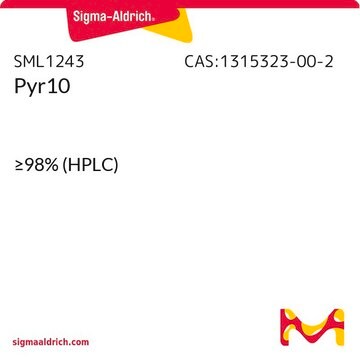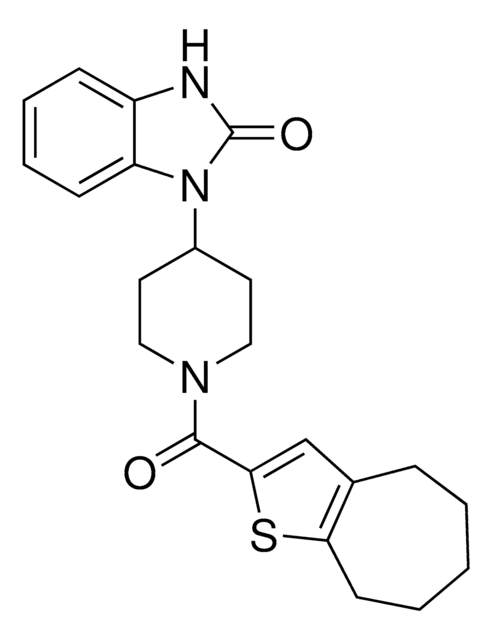P0032
Pyr3
≥98% (HPLC)
Synonyme(s) :
Ethyl-1-(4-(2,3,3-trichloroacrylamide)phenyl)-5-(trifluoromethyl)-1H-pyrazole-4-carboxylate
About This Item
Produits recommandés
Niveau de qualité
Pureté
≥98% (HPLC)
Forme
powder
Couleur
white to beige
Solubilité
DMSO: 20 mg/mL, clear
Température de stockage
2-8°C
Chaîne SMILES
CCOC(=O)c1cnn(-c2ccc(NC(=O)\C(Cl)=C(\Cl)Cl)cc2)c1C(F)(F)F
InChI
1S/C16H11Cl3F3N3O3/c1-2-28-15(27)10-7-23-25(12(10)16(20,21)22)9-5-3-8(4-6-9)24-14(26)11(17)13(18)19/h3-7H,2H2,1H3,(H,24,26)
Clé InChI
RZHGONNSASQOAY-UHFFFAOYSA-N
Actions biochimiques/physiologiques
Members of the canonical transient receptor potential (TRPC) channel family are ion channels which conduct Ca+2 and are activated by membrane receptor-mediated stimulation of phospholipase C (PLC) activity. However, TRPC3 and other family members are also activated by membrane-independent diacylglycerol (DAG). BTP1 and BTP2 are pyrazoles that block TRPC channels, but they are not specific for TRPC subtypes. This channel is implicated in various processes, including B cell receptor (BCR)-mediated Ca+2 oscillations, activation of nuclear factor of activated T cells (NFAT), and promotion of cardiac hypertrophy.
Code de la classe de stockage
11 - Combustible Solids
Point d'éclair (°F)
Not applicable
Point d'éclair (°C)
Not applicable
Certificats d'analyse (COA)
Recherchez un Certificats d'analyse (COA) en saisissant le numéro de lot du produit. Les numéros de lot figurent sur l'étiquette du produit après les mots "Lot" ou "Batch".
Déjà en possession de ce produit ?
Retrouvez la documentation relative aux produits que vous avez récemment achetés dans la Bibliothèque de documents.
Les clients ont également consulté
Notre équipe de scientifiques dispose d'une expérience dans tous les secteurs de la recherche, notamment en sciences de la vie, science des matériaux, synthèse chimique, chromatographie, analyse et dans de nombreux autres domaines..
Contacter notre Service technique










